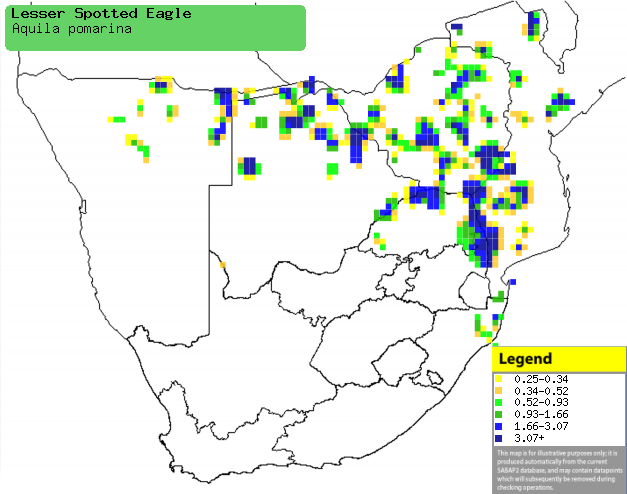|
Aquila pomarina (Lesser spotted
eagle)
Gevlekte arend [Afrikaans]; Ngongo (also applied to Tawny
eagle) [Kwangali]; Schreeuwarend [Dutch]; Aigle pomarin [French];
Schreiadler [German]; Įguia-pomarina [Portuguese]
Life
> Eukaryotes >
Opisthokonta
> Metazoa (animals) >
Bilateria >
Deuterostomia > Chordata >
Craniata > Vertebrata (vertebrates) > Gnathostomata (jawed
vertebrates) > Teleostomi (teleost fish) > Osteichthyes (bony fish) > Class:
Sarcopterygii (lobe-finned
fish) > Stegocephalia (terrestrial
vertebrates) > Tetrapoda
(four-legged vertebrates) > Reptiliomorpha > Amniota >
Reptilia (reptiles) >
Romeriida > Diapsida > Archosauromorpha > Archosauria >
Dinosauria
(dinosaurs) > Saurischia > Theropoda (bipedal predatory dinosaurs) >
Coelurosauria > Maniraptora > Aves
(birds) > Order: Falconiformes
> Family: Accipitridae
> Genus: Aquila
Distribution and habitat
It breeds in eastern Europe, heading south in the non-breeding season to Africa,
from Egypt to South Africa. In southern Africa, it is locally common in patches of Mozambique, Zimbabwe, northern
Botswana, north-eastern Namibia (including the Caprivi Strip) and north-eastern
South Africa. It generally prefers savanna and open woodland, generally avoiding
mountainous and densely wooded areas.
|
 |
|
Distribution of Lesser spotted eagle in southern Africa,
based on statistical smoothing of the records from first SA Bird Atlas
Project (©
Animal Demography unit, University of
Cape Town; smoothing by Birgit Erni and Francesca Little). Colours range
from dark blue (most common) through to yellow (least common).
See here for the latest distribution
from the SABAP2. |
Movements and migrations
Palearctic breeding migrant, arriving in
southern Africa in October; most birds depart in March.
Food
It mainly eats termite alates in southern Africa, foraging
on the ground or hawking prey from a perch. The following food items have been recorded
in its diet:
- Termite alates
- Hodotermes mossambicus (Northern harvester termite)
- Vertebrates
Threats
Not threatened, although its population appears to be
decreasing sharply. This trend is possibly caused by radioactive fallout from Chernobyl, hunting
and habitat loss for agriculture.
References
-
Hockey PAR, Dean WRJ and Ryan PG 2005. Roberts
- Birds of southern Africa, VIIth ed. The Trustees of the John Voelcker
Bird Book Fund, Cape Town.
|
